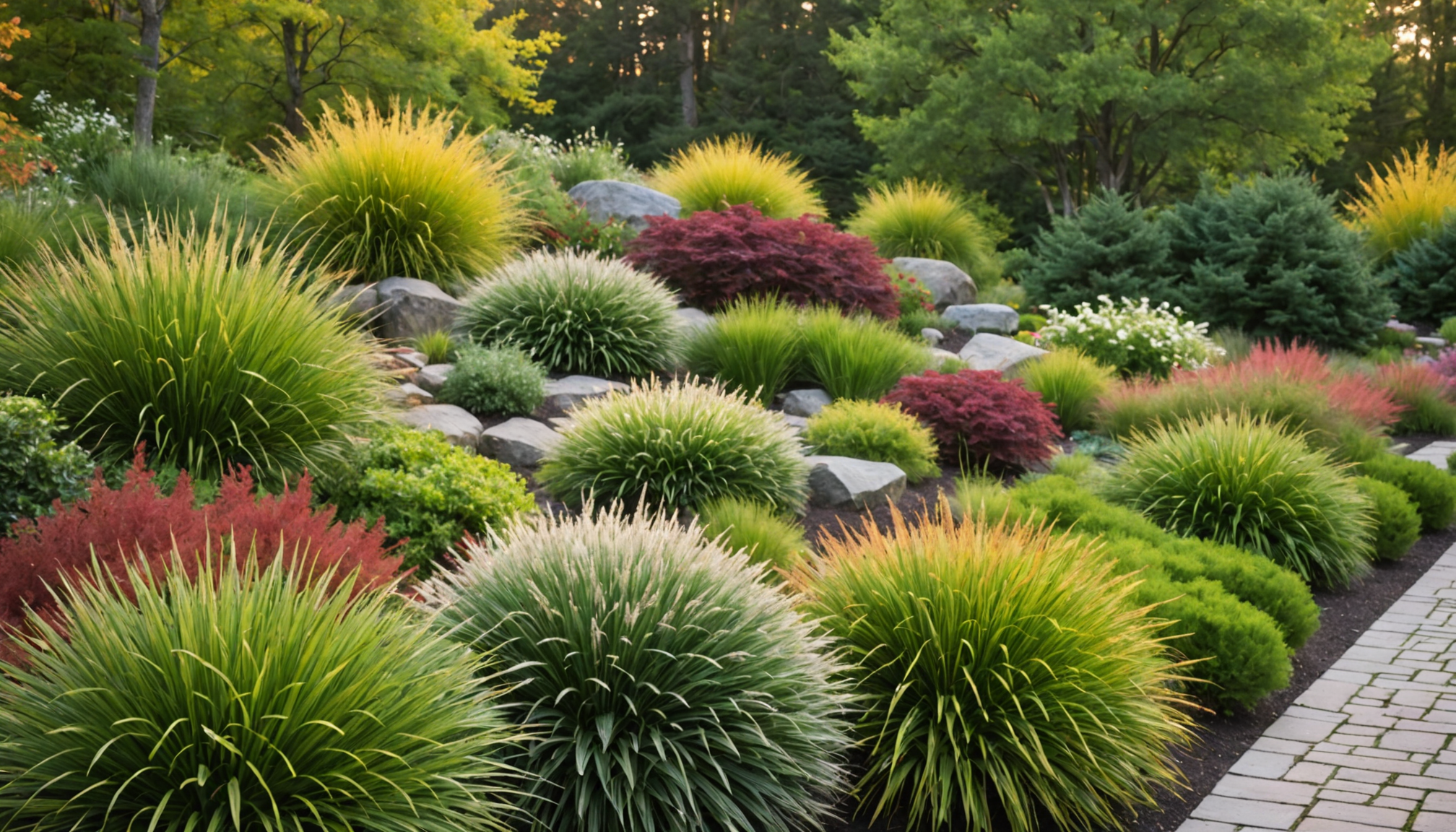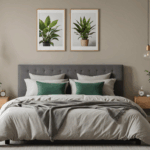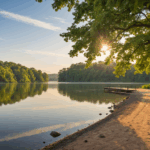Selecting the appropriate plants is an essential aspect of decorating your yard, transforming it into an inviting oasis. The right vegetation not only enhances the aesthetic appeal but also contributes to sustainable landscaping, which is both environmentally friendly and practical for long-term maintenance.
Begin by considering the climate and soil conditions of your area. Plants that are native to your region are more likely to thrive, requiring less water and maintenance. For a modern touch, incorporate a mix of shrubs, perennials, and ornamental grasses that offer varying textures and heights. This variety can create a layered look that is both visually appealing and functional.
When choosing plants, it’s crucial to think about color and seasonal changes. Select species that bloom at different times of the year to ensure your yard remains vibrant throughout all seasons. Consider the use of evergreens for year-round foliage, complemented by flowering plants for bursts of seasonal color.
Contributing to the safety of your yard, opting for non-toxic plants, especially if children or pets frequent your outdoor space, is indispensable. Always research the plants you plan to introduce, ensuring they do not pose hazards.
The layout of plantings should reflect your yard’s structural flow, which should seamlessly integrate with pathways and other landscaping features. Incorporate ground covers to serve as the natural flooring of your yard, providing a visually cohesive transition between different plant areas. By strategically placing taller plants at the back and smaller ones at the front or bordering paths, you can develop a structured yet organic look that guides movement and highlights focal areas.
| Plant Type | Water Requirement | Seasonal Interest |
| Native Shrubs | Low | Spring Blooms |
| Ornamental Grasses | Moderate | Year-Round Texture |
| Perennials | Varies | Summer to Fall Flowers |
| Evergreens | Low | Winter Foliage |
Integrating these elements thoughtfully will help you to achieve a well-decorated yard that not only meets aesthetic goals but functions harmoniously within its environment. Tailoring plant choices to the specific conditions of your space can lead to a flourishing garden, enhancing both the beauty and enjoyment of your outdoor area.
incorporate outdoor lighting
Outdoor lighting is an essential element in transforming your yard into a welcoming, functional space that can be enjoyed both day and night. When strategically placed, it not only highlights key features but also enhances safety and security. Follow these steps to effectively incorporate outdoor lighting into your yard design:
1. Assess Your Space: Begin by walking around your yard during dusk to identify areas where lighting could be most beneficial. Consider places that would benefit from illumination for both decorative and safety purposes, such as pathways, entranceways, steps, and focal points like statues or water features.
2. Choose the Right Type of Lighting: Different areas of your yard will require various types of lighting solutions:
– Ambient Lighting: Provides general illumination and creates a comfortable level of brightness. Examples include overhead lanterns or string lights draped over seating areas.
– Task Lighting: Primarily used for specific purposes, such as lighting pathways or stairs, to prevent tripping and ensure safety. Think of solar or battery-powered pathway lights.
– Accent Lighting: Used to highlight specific elements in your yard, such as a beautiful tree or a decorative wall. Spotlights or uplights are ideal for this purpose.
3. Plan Your Layout:
– Pathways: Use low-level lights to clearly outline paths and walkways. Position them along the edges to guide the way and enhance safety.
– Entrances: Brighten up entry points with wall-mounted fixtures or small sconces. This not only boosts safety but makes your home feel welcoming.
– Focal Points: Direct spotlights or uplights towards key features to draw the eye and create drama. Ensure that the lighting angles do not produce glare or harsh shadows.
4. Install the Fixtures:
– Follow manufacturer instructions for installing each type of fixture, ensuring they are suitable for outdoor use and have the correct waterproofing ratings.
– Position solar lights in areas where they will receive adequate sunlight to recharge, thus maintaining their efficiency.
– If using electric lighting, plan the wiring layout to minimize visibility and avoid safety hazards.
5. Add Finishing Touches:
– Experiment with different lighting intensities and colors to achieve the desired ambiance. Bulbs in warmer tones often create a more inviting atmosphere.
– Consider using smart lighting solutions that allow you to adjust brightness settings via a mobile app, providing flexibility as you set the mood for various occasions.
By taking the time to plan and install outdoor lighting effectively, you can enhance both the aesthetic appeal and functionality of your yard. These lighting techniques will not only illuminate your space but also transform it into a modern outdoor oasis that can be enjoyed year-round.
add functional furniture
When you think about creating an inviting outdoor space, one of the primary considerations should be the selection of practical yet stylish furniture that complements your landscape. The right outdoor furniture does more than just decorate your yard; it establishes a welcoming atmosphere while providing functionality. Here’s how to make the most out of your outdoor furnishings:
Firstly, it’s essential to assess the purpose of your outdoor area. Are you aiming for a space to relax, entertain guests, or dine al fresco? Once you’ve identified the primary use, you can choose pieces that support these activities. A cozy seating arrangement, such as a sectional sofa coupled with a coffee table, can transform your yard into a lounge area perfect for unwinding. In contrast, a sturdy, extendable dining table with weather-resistant chairs can accommodate gatherings and meal times.
Material choice is crucial in ensuring that your furniture withstands the elements while maintaining a modern aesthetic. Opt for materials like teak, metal, or all-weather wicker, which are known for their durability and low maintenance. Look for cushions and upholstery made from fade-resistant and water-repellent fabrics to extend the longevity of your outdoor setup. These materials are not only practical but also contribute to the overall appearance of the yard.
Placement of the furniture should encourage natural interaction with the surrounding environment. Consider positioning the pieces to take advantage of the shade provided by trees or pergolas, ensuring comfort during sunny afternoons. This arrangement not only enhances comfort but can also serve as such focal points, visually balancing the other elements in your yard.
Storage adds to the usability and cleanliness of your outdoor space, especially in preventing clutter. Incorporate multifunctional items like benches or ottomans with hidden compartments to keep essentials like pillows or garden tools neatly tucked away. This method of integrating storage solutions enhances both the beauty and tidiness of your yard without detracting from your stylish décor.
Finally, it’s important to layer in appropriate accessories to personalize your space. Throw pillows, outdoor rugs, and cozy blankets add texture and warmth, making your yard feel like an extension of your home. Accessories like these allow for seasonal updates, enabling you to freshen up the look and feel with minimal effort.
By carefully choosing and arranging functional furniture in your yard, you create a seamless blend of aesthetics and practicality. This approach not only boosts the appeal of your outdoor area but ensures a versatile and inviting setting that adapts to your needs year-round.
create focal points
In your yard, establishing focal points can create a sense of intrigue and guide the viewer’s eye throughout the landscape, making it more inviting and visually appealing. The concept involves selecting particular elements or areas that stand out through design, color, or placement. These can be anything from a striking sculpture to a vibrant flower bed. Here’s how you can incorporate such highlights:
Start by considering the existing layout and identifying areas lacking visual interest or flow. Focal points should naturally draw attention and encourage movement through your yard, so it’s vital to position them thoughtfully within the space. Think of the areas that might benefit from enhancement, such as the center of a garden section, a corner near a seating area, or an entrance.
Choosing the right feature for a focal point depends on the overall theme and style you want to achieve. More modern yards might benefit from contemporary sculptures or minimalist water features, while a rustic yard could be enhanced by a large, tastefully aged urn or a quaint birdbath surrounded by lush greenery. The key is selecting decor pieces that resonate with your yard’s aesthetic and become a noticeable highlight without disrupting harmony.
Color plays an essential role in creating focal points. Use vibrant blooms or foliage to break up monotone areas. Bold splashes of color in strategic spots can instantly draw the eye. Consider seasonal plants that can be interchanged to keep the focal area lively and relevant throughout the year. This not only enhances the aesthetic appeal but also allows for fresh transformations that keep the space dynamic.
Incorporate structural elements like pergolas or arbors adorned with climbing plants to add vertical interest and create a dramatic header for your garden. These features, often considered an additional “flooring” above the ground, can define a space within the landscape, inviting guests to explore different areas while providing shade and a modern edge to your design.
Use lighting to your advantage to emphasize these focal points during the evening. Spotlights aimed at a key feature ensure it remains the center of attention. Lighting not only makes your focal points stand out but also enhances safety, providing illumination that prevents trips and falls during nighttime gatherings.
Lastly, focal points can evolve. Don’t hesitate to refresh them periodically with new plants, accessories, or decor that reflect changing seasons or personal tastes. By doing so, your yard stays current, captivating, and aligned with your vision.
These strategies go beyond mere decoration and help you establish areas of interest that narrate a story within your garden, transforming your yard into a dynamic, engaging space.
utilize pathways and borders
Pathways and borders are often underutilized elements in a yard, yet they have immense potential to enhance the landscape’s decorative and functional aspects. Creating well-defined paths and borders can not only improve the overall flow and accessibility of your outdoor space but also serve as an elegant way to highlight key features.
Start by planning the layout, considering how pathways will connect different areas of your yard and encourage movement. Thoughtful placement of paths is crucial—whether they gently guide visitors to various focal points or curve playfully through the greenery, they should complement the natural terrain and lead the eye seamlessly through the landscape.
Materials play a significant role in both the aesthetics and durability of pathways. Choose materials that align with the overall style of your yard while offering resilience against weather conditions. Stone or brick pavers contribute a classic or rustic charm, ideal for more traditional settings, while sleek concrete or slate can introduce a touch of modern flair. Whichever you select, ensure they are of non-slip variety to enhance safety and are easy to maintain.
For the borders, use them to define garden beds, separate different zones in your yard, or edge pathways. This definition can be achieved using various elements, such as stones, bricks, or even low hedges. Choose materials and plants that create a cohesive look. Clusters of colorful flowers or neatly trimmed shrubs can enhance the sense of organization and depth, making your outdoor space feel complete and thoughtfully arranged.
Incorporating pathways and borders is not only about organizing the space but also about storytelling through design. Accentuate the edges with ornamental grasses or perennials for soft texture and seasonal interest. This will not only serve as attractive flooring for your garden beds but also create a pleasant transition from one area to another.
Path lighting should not be overlooked; it can elevate both the attractiveness and safety of your paths. Low-level solar lights strategically placed along the edges of paths can provide a welcoming glow, making your yard usable and inviting even in the dusk hours.
These details go beyond mere decoration, offering functionality and continuity within your outdoor area. With well-planned pathways and borders, your yard becomes a more accessible and visually engaging environment.
—
Concluding an effective yard decorating project involves a few key strategies that intertwine aesthetics with functionality. By choosing the right plants, incorporating strategic lighting, selecting functional furniture, creating focal points, and utilizing pathways and borders thoughtfully, you create a harmonious outdoor space that is both welcoming and visually appealing. Transforming your yard into a reflection of your personal style and practical needs promises a sanctuary that can be enjoyed throughout every season.


